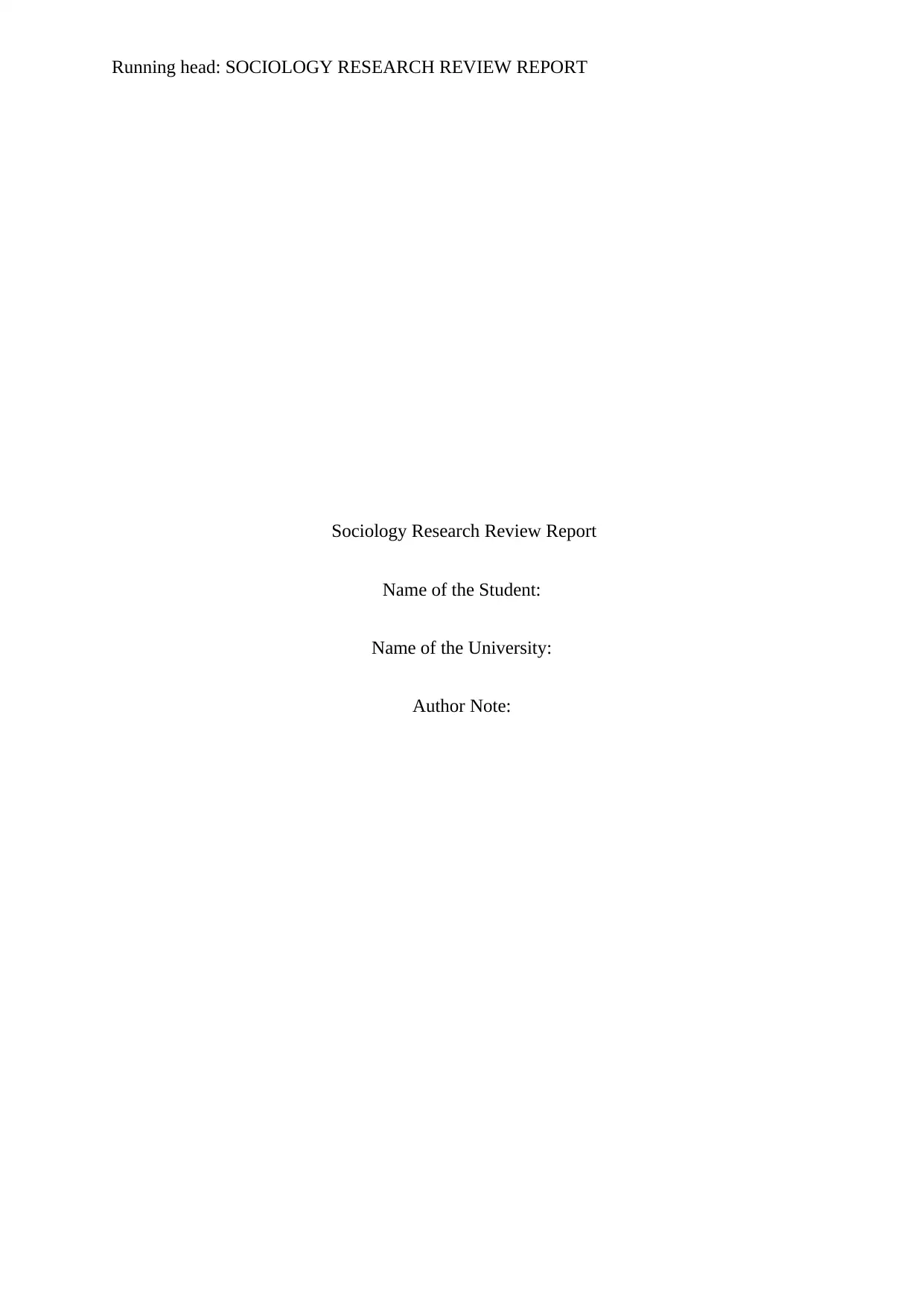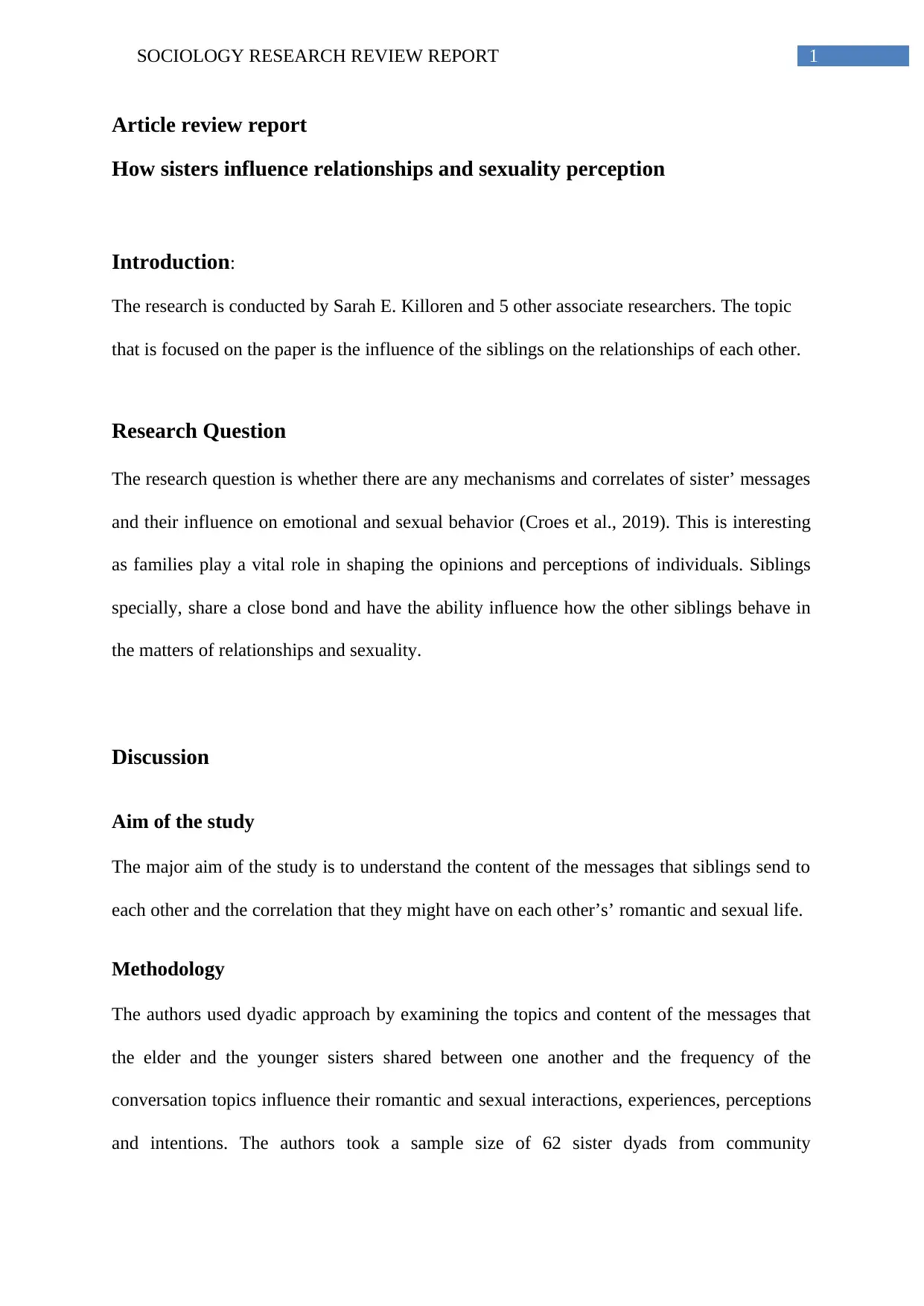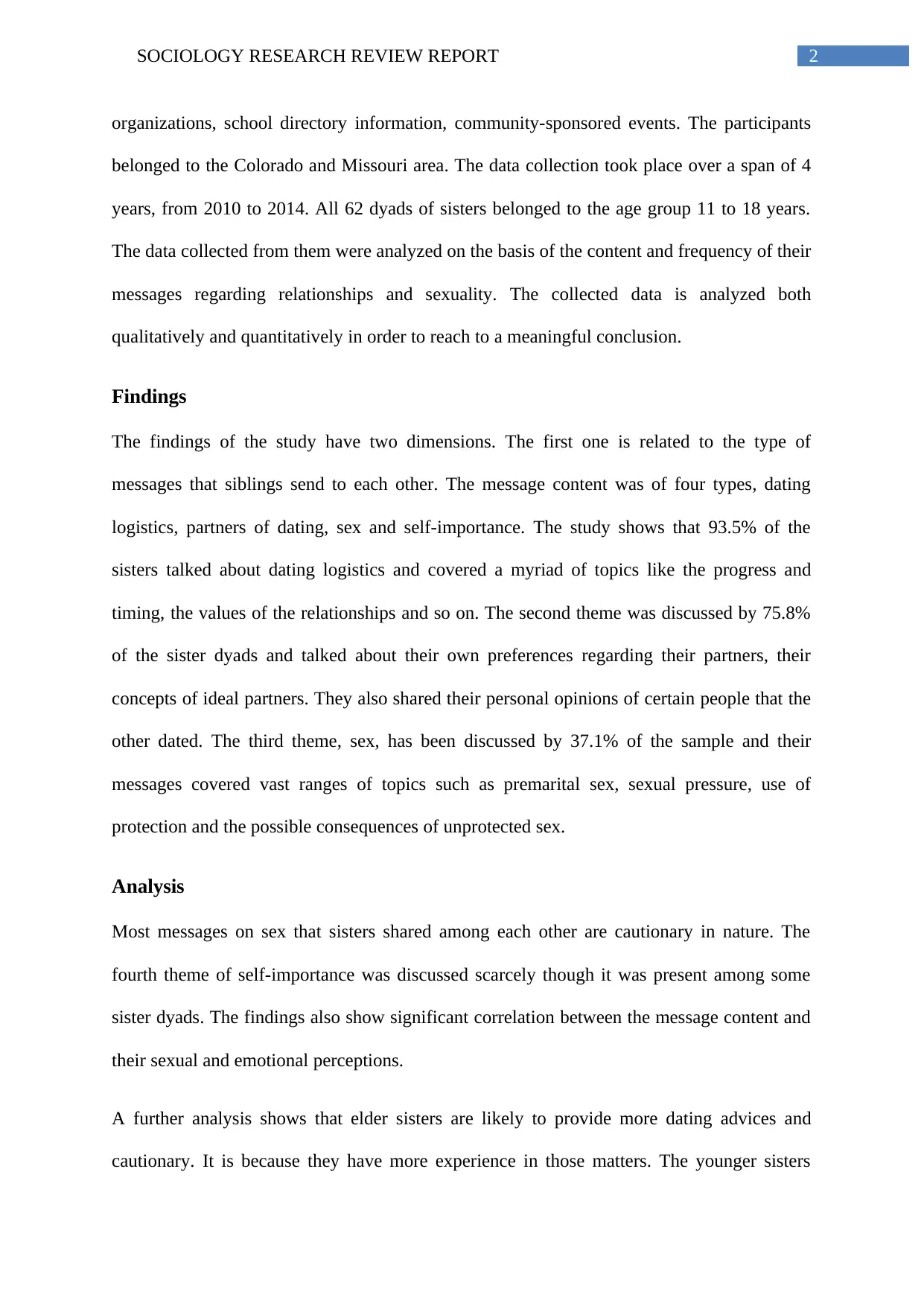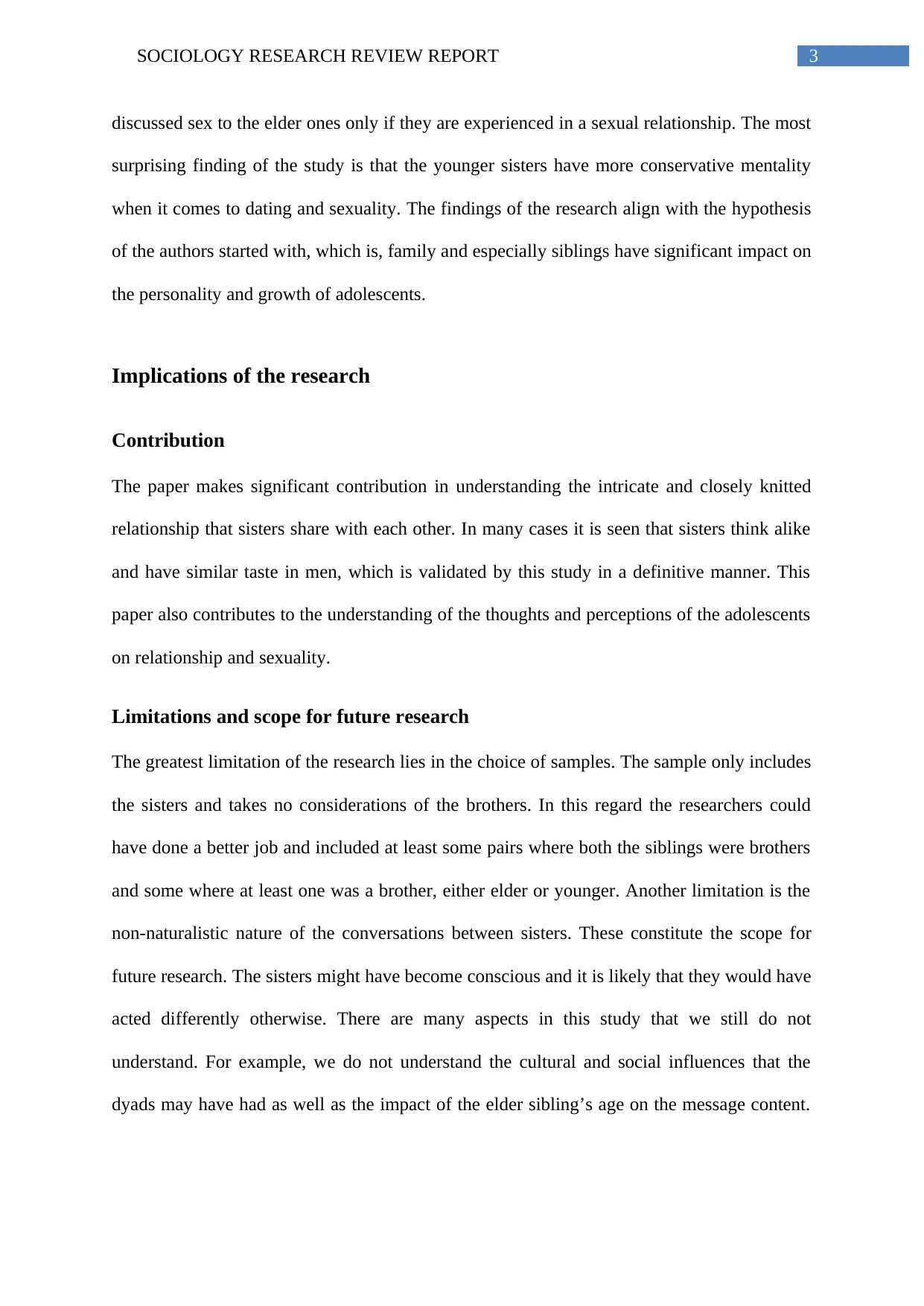Sociology Research Review Report for PSY350 Course - University
VerifiedAdded on 2022/12/29
|6
|1019
|93
Report
AI Summary
This report is a review of research conducted by Killoren et al. on the influence of sisters on each other's relationships and sexuality. The study explores the messages exchanged between sisters (aged 11-18) regarding dating, partners, sex, and self-importance, using a dyadic approach with 62 sister dyads from Colorado and Missouri. Findings indicate that sisters discuss dating logistics, partner preferences, and sex, with elder sisters often providing advice. The research highlights a correlation between message content and emotional/sexual perceptions, revealing conservative views among younger sisters. The report discusses the study's contributions, limitations (sample size, non-naturalistic conversations), and scope for future research, emphasizing the need to explore cultural and social influences, and the role of brothers. The study concludes that siblings have a significant impact on the personality and growth of adolescents.

Running head: SOCIOLOGY RESEARCH REVIEW REPORT
Sociology Research Review Report
Name of the Student:
Name of the University:
Author Note:
Sociology Research Review Report
Name of the Student:
Name of the University:
Author Note:
Paraphrase This Document
Need a fresh take? Get an instant paraphrase of this document with our AI Paraphraser

1SOCIOLOGY RESEARCH REVIEW REPORT
Article review report
How sisters influence relationships and sexuality perception
Introduction:
The research is conducted by Sarah E. Killoren and 5 other associate researchers. The topic
that is focused on the paper is the influence of the siblings on the relationships of each other.
Research Question
The research question is whether there are any mechanisms and correlates of sister’ messages
and their influence on emotional and sexual behavior (Croes et al., 2019). This is interesting
as families play a vital role in shaping the opinions and perceptions of individuals. Siblings
specially, share a close bond and have the ability influence how the other siblings behave in
the matters of relationships and sexuality.
Discussion
Aim of the study
The major aim of the study is to understand the content of the messages that siblings send to
each other and the correlation that they might have on each other’s’ romantic and sexual life.
Methodology
The authors used dyadic approach by examining the topics and content of the messages that
the elder and the younger sisters shared between one another and the frequency of the
conversation topics influence their romantic and sexual interactions, experiences, perceptions
and intentions. The authors took a sample size of 62 sister dyads from community
Article review report
How sisters influence relationships and sexuality perception
Introduction:
The research is conducted by Sarah E. Killoren and 5 other associate researchers. The topic
that is focused on the paper is the influence of the siblings on the relationships of each other.
Research Question
The research question is whether there are any mechanisms and correlates of sister’ messages
and their influence on emotional and sexual behavior (Croes et al., 2019). This is interesting
as families play a vital role in shaping the opinions and perceptions of individuals. Siblings
specially, share a close bond and have the ability influence how the other siblings behave in
the matters of relationships and sexuality.
Discussion
Aim of the study
The major aim of the study is to understand the content of the messages that siblings send to
each other and the correlation that they might have on each other’s’ romantic and sexual life.
Methodology
The authors used dyadic approach by examining the topics and content of the messages that
the elder and the younger sisters shared between one another and the frequency of the
conversation topics influence their romantic and sexual interactions, experiences, perceptions
and intentions. The authors took a sample size of 62 sister dyads from community

2SOCIOLOGY RESEARCH REVIEW REPORT
organizations, school directory information, community-sponsored events. The participants
belonged to the Colorado and Missouri area. The data collection took place over a span of 4
years, from 2010 to 2014. All 62 dyads of sisters belonged to the age group 11 to 18 years.
The data collected from them were analyzed on the basis of the content and frequency of their
messages regarding relationships and sexuality. The collected data is analyzed both
qualitatively and quantitatively in order to reach to a meaningful conclusion.
Findings
The findings of the study have two dimensions. The first one is related to the type of
messages that siblings send to each other. The message content was of four types, dating
logistics, partners of dating, sex and self-importance. The study shows that 93.5% of the
sisters talked about dating logistics and covered a myriad of topics like the progress and
timing, the values of the relationships and so on. The second theme was discussed by 75.8%
of the sister dyads and talked about their own preferences regarding their partners, their
concepts of ideal partners. They also shared their personal opinions of certain people that the
other dated. The third theme, sex, has been discussed by 37.1% of the sample and their
messages covered vast ranges of topics such as premarital sex, sexual pressure, use of
protection and the possible consequences of unprotected sex.
Analysis
Most messages on sex that sisters shared among each other are cautionary in nature. The
fourth theme of self-importance was discussed scarcely though it was present among some
sister dyads. The findings also show significant correlation between the message content and
their sexual and emotional perceptions.
A further analysis shows that elder sisters are likely to provide more dating advices and
cautionary. It is because they have more experience in those matters. The younger sisters
organizations, school directory information, community-sponsored events. The participants
belonged to the Colorado and Missouri area. The data collection took place over a span of 4
years, from 2010 to 2014. All 62 dyads of sisters belonged to the age group 11 to 18 years.
The data collected from them were analyzed on the basis of the content and frequency of their
messages regarding relationships and sexuality. The collected data is analyzed both
qualitatively and quantitatively in order to reach to a meaningful conclusion.
Findings
The findings of the study have two dimensions. The first one is related to the type of
messages that siblings send to each other. The message content was of four types, dating
logistics, partners of dating, sex and self-importance. The study shows that 93.5% of the
sisters talked about dating logistics and covered a myriad of topics like the progress and
timing, the values of the relationships and so on. The second theme was discussed by 75.8%
of the sister dyads and talked about their own preferences regarding their partners, their
concepts of ideal partners. They also shared their personal opinions of certain people that the
other dated. The third theme, sex, has been discussed by 37.1% of the sample and their
messages covered vast ranges of topics such as premarital sex, sexual pressure, use of
protection and the possible consequences of unprotected sex.
Analysis
Most messages on sex that sisters shared among each other are cautionary in nature. The
fourth theme of self-importance was discussed scarcely though it was present among some
sister dyads. The findings also show significant correlation between the message content and
their sexual and emotional perceptions.
A further analysis shows that elder sisters are likely to provide more dating advices and
cautionary. It is because they have more experience in those matters. The younger sisters
⊘ This is a preview!⊘
Do you want full access?
Subscribe today to unlock all pages.

Trusted by 1+ million students worldwide

3SOCIOLOGY RESEARCH REVIEW REPORT
discussed sex to the elder ones only if they are experienced in a sexual relationship. The most
surprising finding of the study is that the younger sisters have more conservative mentality
when it comes to dating and sexuality. The findings of the research align with the hypothesis
of the authors started with, which is, family and especially siblings have significant impact on
the personality and growth of adolescents.
Implications of the research
Contribution
The paper makes significant contribution in understanding the intricate and closely knitted
relationship that sisters share with each other. In many cases it is seen that sisters think alike
and have similar taste in men, which is validated by this study in a definitive manner. This
paper also contributes to the understanding of the thoughts and perceptions of the adolescents
on relationship and sexuality.
Limitations and scope for future research
The greatest limitation of the research lies in the choice of samples. The sample only includes
the sisters and takes no considerations of the brothers. In this regard the researchers could
have done a better job and included at least some pairs where both the siblings were brothers
and some where at least one was a brother, either elder or younger. Another limitation is the
non-naturalistic nature of the conversations between sisters. These constitute the scope for
future research. The sisters might have become conscious and it is likely that they would have
acted differently otherwise. There are many aspects in this study that we still do not
understand. For example, we do not understand the cultural and social influences that the
dyads may have had as well as the impact of the elder sibling’s age on the message content.
discussed sex to the elder ones only if they are experienced in a sexual relationship. The most
surprising finding of the study is that the younger sisters have more conservative mentality
when it comes to dating and sexuality. The findings of the research align with the hypothesis
of the authors started with, which is, family and especially siblings have significant impact on
the personality and growth of adolescents.
Implications of the research
Contribution
The paper makes significant contribution in understanding the intricate and closely knitted
relationship that sisters share with each other. In many cases it is seen that sisters think alike
and have similar taste in men, which is validated by this study in a definitive manner. This
paper also contributes to the understanding of the thoughts and perceptions of the adolescents
on relationship and sexuality.
Limitations and scope for future research
The greatest limitation of the research lies in the choice of samples. The sample only includes
the sisters and takes no considerations of the brothers. In this regard the researchers could
have done a better job and included at least some pairs where both the siblings were brothers
and some where at least one was a brother, either elder or younger. Another limitation is the
non-naturalistic nature of the conversations between sisters. These constitute the scope for
future research. The sisters might have become conscious and it is likely that they would have
acted differently otherwise. There are many aspects in this study that we still do not
understand. For example, we do not understand the cultural and social influences that the
dyads may have had as well as the impact of the elder sibling’s age on the message content.
Paraphrase This Document
Need a fresh take? Get an instant paraphrase of this document with our AI Paraphraser

4SOCIOLOGY RESEARCH REVIEW REPORT
Conclusion
The above analysis concludes that there is much to explore when it comes to sibling
messages and the correlates on dating and sexuality. Future scientists should dive deeper into
the cultural and social influences that create opinions and the role of brother siblings on the
same topic.
Conclusion
The above analysis concludes that there is much to explore when it comes to sibling
messages and the correlates on dating and sexuality. Future scientists should dive deeper into
the cultural and social influences that create opinions and the role of brother siblings on the
same topic.

5SOCIOLOGY RESEARCH REVIEW REPORT
References
Croes, E. A. J., Antheunis, M. L., Schouten, A. P., & Krahmer, E. J. (2019). Social attraction
in video-mediated communication: The role of nonverbal affiliative behavior. Journal
of Social and Personal Relationships, 36(4), 1210-1232.
doi:10.1177/0265407518757382
References
Croes, E. A. J., Antheunis, M. L., Schouten, A. P., & Krahmer, E. J. (2019). Social attraction
in video-mediated communication: The role of nonverbal affiliative behavior. Journal
of Social and Personal Relationships, 36(4), 1210-1232.
doi:10.1177/0265407518757382
⊘ This is a preview!⊘
Do you want full access?
Subscribe today to unlock all pages.

Trusted by 1+ million students worldwide
1 out of 6
Your All-in-One AI-Powered Toolkit for Academic Success.
+13062052269
info@desklib.com
Available 24*7 on WhatsApp / Email
![[object Object]](/_next/static/media/star-bottom.7253800d.svg)
Unlock your academic potential
Copyright © 2020–2025 A2Z Services. All Rights Reserved. Developed and managed by ZUCOL.
